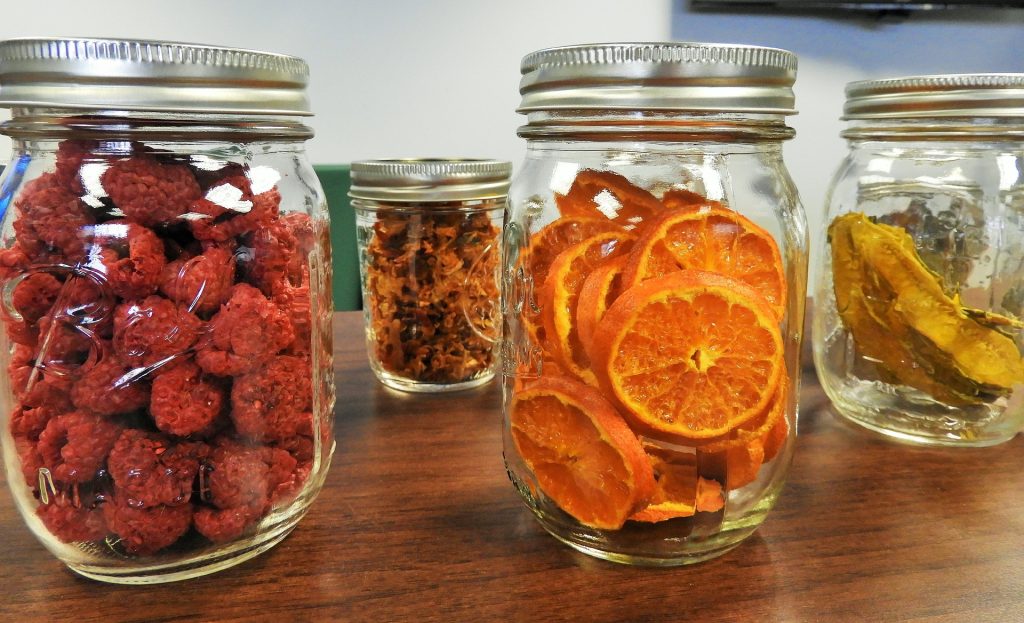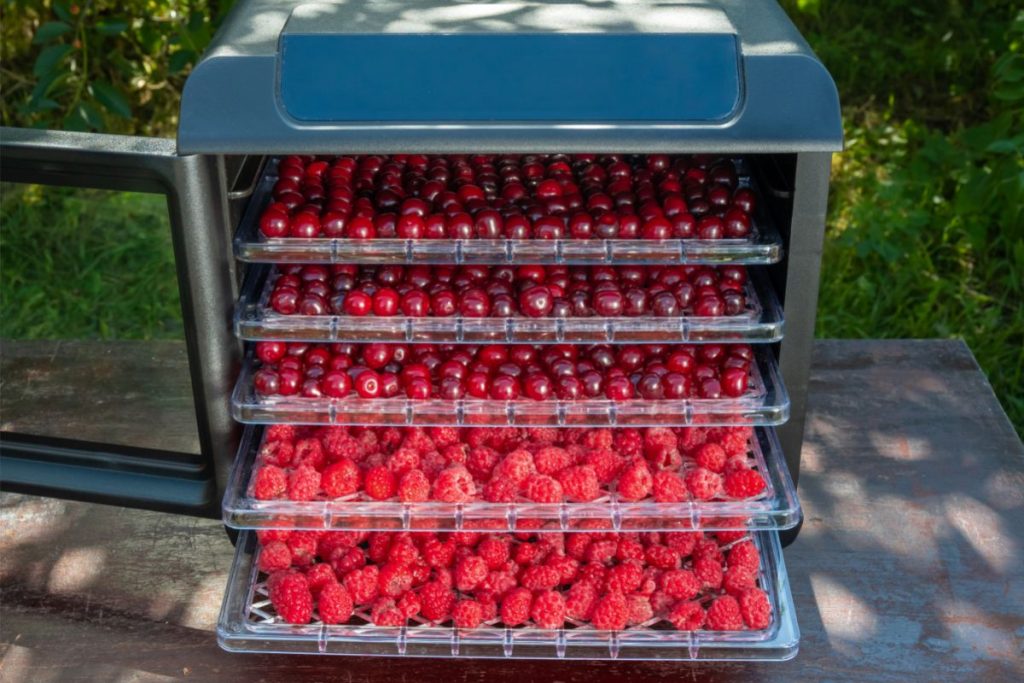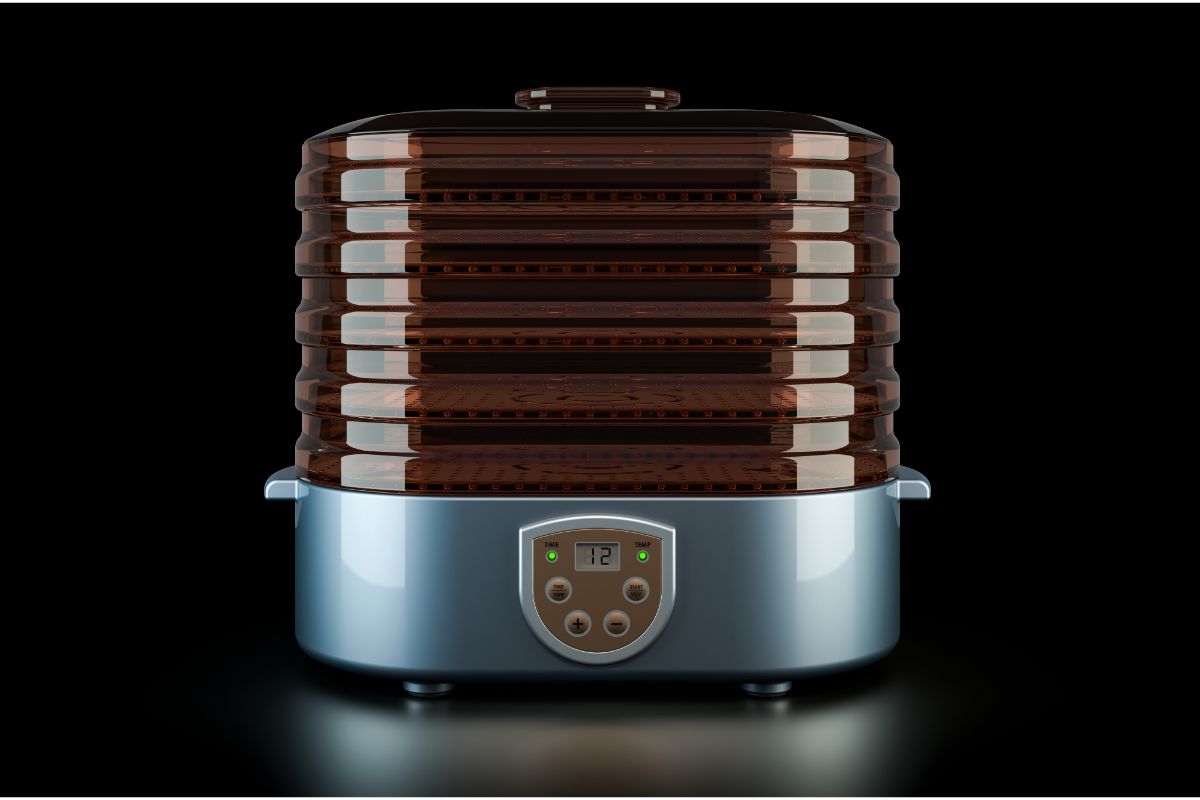Most food dehydrators are simple to operate, with a digital display and removable dehydrator trays. Always read the manufacturer’s instructions and stick to the recommended temperature settings and drying times for your machine.
Table of Contents
Guide to Using a Food Dehydrator
Prior to using your dehydrator for the first time, check the manufacturer’s instructions on using that specific model. These instructions come with the dehydrator as a small handbook. If a booklet isn’t included, check online for the instructions before operating the machine.
The general process of using a food dehydrator usually follows these steps:
- Ensure the dehydrator is clean before using it, especially the interior walls and food trays.
- Preheat the dehydrator to the recommended temperature for drying the food you want to prepare.
- Prepare the food you will be dehydrating. Most food requires specific preparation techniques. For example, meat must be cooked, and veggies should be blanched before dehydrating.
- If the type of food is large or thick, slice the food into small, uniform pieces.
- Place the prepared food on the dehydrator trays in single layers, with or without parchment paper, depending on the nature of the food and the material of the trays.
- Set the dehydrator to the recommended temperature and drying time. Most foods dry at 120°F-140°F. Meats require higher temperatures of up to 160°F.
- Always check on the food as it is dehydrating. If you notice it’s losing moisture too quickly and the outer skin seems cooked rather than dried, reduce the drying temperature.
- Periodically flip the food pieces and move any rotatable dehydrator trays to ensure even drying.
- At the end of the drying process, take a few pieces of the food out and allow them to cool to room temperature before testing for dryness.
- Continue the dehydration process for food that is still moist.
- Remove food that is completely dried and allow it to cool to room temperature.
- Condition the dry food by putting it in clear, airtight containers. Allow it to sit for a few days to a week, and shake the container once a day to ensure condensation doesn’t form on the interior of the container. Condensation indicates moisture and a product that isn’t fully dry.
- After conditioning and ensuring the food is thoroughly dried, label and store the food in a cool, dry place away from heat and direct sunlight.

How Does a Food Dehydrator Work?
A food dehydrator removes moisture content from food by circulating hot air over it at low temperatures for an extended period of time.
The heating element is the heat source that warms the cooked or raw food on the dehydrator trays to extract the moisture content.
The fan circulates the heat, draws in dry air from outside, and removes moisture through the vents to ensure a moisture-free environment.
Types of Food Dehydrators
There are two types of food dehydrators, and they are classified based on the location of the fan and the direction of the airflow.
Vertical airflow food dehydrators have a fan either at the top or bottom of the machine. Air is forced vertically through the dehydrator trays. Vertical airflow dehydrators tend to be less expensive.
Horizontal airflow dehydrators are better at air circulation and even dehydration. The fan sits at the back of the device and blows hot air towards the dehydrator door, equally across all the trays. Most high-end food dehydrators have horizontal airflow.
You can find both types of dehydrators from reliable food dehydrator brands such as Nesco, Excalibur, Gourmia, Tribest, Cosori, and Magic Mill.

How to Choose the Best Food Dehydrator
Choosing a food dehydrator can be difficult because many models have similar features. In order to choose the best food dehydrator for your needs, it’s important to understand how the different components operate.
Adjustable Thermostat and Temperature Range
A wide temperature range is ideal for shifting between the temperature needs of different types of food. Unless you plan on only dehydrating one type of food (such as jerky), it is advisable to look for a dehydrator with an adjustable thermostat.
Automatic Shut-off
When operating a food dehydrator, check on the food regularly and use an automatic shut-off as a backup system.
The advantage of an automatic shut-off system is that you can leave your food to dry at the set temperature for the specified time and have it end the dehydration process automatically.
The disadvantage is that it may automatically turn off when your food is not fully dried, which is why checking food regularly and adjusting the shut-off is best.
Fan Location and Airflow System
Dehydrators with a back-mounted fan offer even airflow and drying. Dehydrators with top or bottom fans don’t dry food as evenly and will require tray rotation.
Stackable vs. Sliding Trays
Stackable tray dehydrators have more capacity. You can often purchase additional trays if you prefer to make large batches. However, most stackable models are vertical flow with a top or bottom-mounted fan.
Sliding tray dehydrators are more efficient than their stackable tray counterparts and have a back-mounted fan. These models are bulkier, have fewer trays, and offer less drying space, but often do a better job dehydrating.
Tray Material
If you are concerned with the BPA present in some plastic trays, buy a dehydrator with stainless steel trays. Alternatively, buy BPA-free trays or cover plastic trays with parchment paper or silicone mats before loading your food.
Avoid dehydrators with galvanized metal or aluminum trays. The acids in food may corrode these trays and cause chemicals to leach into your food.

How Long Does it Take to Dehydrate Food in a Dehydrator?
Most fruits and vegetables take 6-10 hours to dehydrate at 125°F-140°F. Herbs take the least amount of drying time (2-4 hours), while pre-cooked meat can take up to 12 hours.
It’s important to note that these are general drying times for different foods. You must always check the manufacturer’s instructions for the recommended amount of time for each type of food.
What Kinds of Foods Can be Dehydrated?
You can dehydrate the following foods:
- Cooked food such as pasta, stews, and granola
- Dairy, such as homemade yogurt
- Fresh fruits such as kiwis, apples, and blueberries
- Fruit leather
- Herbs including lavender, oregano, and mint
- Honey
- Pet food
- Precooked meats, such as fish, turkey jerky, chicken, beef jerky, and pork
- Sauces, syrups, and jams
- Seeds, nuts, and grains
- Vegetables including sweet potatoes, zucchini, beets, and celery

How Do You Know When Food is Dehydrated?
Dried food is completely dehydrated if no moisture oozes out when you squeeze it after cooling it to room temperature.
Completely dried vegetables should be brittle and hard. Dried fruits are leathery and pliable when completely dehydrated.
Preparing Dehydrated Food Tips
- Always rinse food thoroughly in cool running water
- Cut foods into small, even pieces for even drying
- Precook lean meats to kill foodborne pathogens and bacteria
- Select high-quality, fresh food to dehydrate for the best results
- Soak seeds and nuts to make them easier to dry
How to Store Dehydrated Food
Always keep dried food in a cool, dry, dark place and label all food storage containers. Use dry, clean, airtight containers to store dried food.
Consider freezing dehydrated fruits, veggies, and cooked foods to extend their shelf-life. If you wish to store these foods at room temperature, use them within one year for the best flavor.

